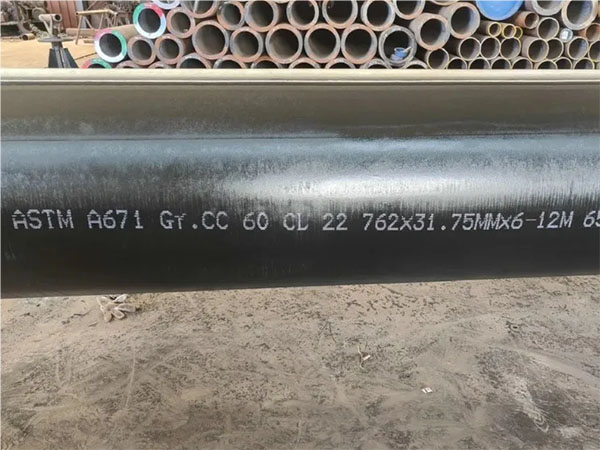ASTM A671 Carbon steel pipe is a carbon steel pipe manufactured according to ASTM A671 standard, and its manufacturing process is EFW (Electric Fusion Welding) technology. Made from a variety of analytical and strength grades of pressure vessel quality sheets, suitable for high pressure service at atmospheric and lower temperatures. Heat treatment may or may not be required to obtain desired properties or to meet applicable regulatory requirements.
What is ASTM A671 and EFW Process?
The ASTM A671 standard represents low-temperature electrofusion welded steel pipes, and the steel pipes regulated by this standard specifically refer to
welded steel pipes. The A671 specification nominally covers pipes with an outer diameter of 16 inches (405 mm) or greater and a wall thickness of 1/4 inch (6.4 mm) or greater.
EFW (electric fusion welding) process uses electric energy to directly heat the pipe joint area, so that the base metal is partially melted, and the weld metal is fully fused through pressure to form a high-quality continuous weld. Compared with traditional welding processes, EFW provides better control of heat input and welding temperature, thereby reducing heat-affected zones and improving weld performance.

Manufacturing process
1. Preparation of raw materials
The selection of low carbon steel plate or steel strip in accordance with ASTM A671 requirements as the base material to ensure that the chemical composition and mechanical properties meet the standards.
2. Forming and stamping
Steel is formed into a predetermined tube shape by cold bending or stamping. This step needs to ensure the uniformity of the size and wall thickness of the tube billet, which provides a good basis for subsequent welding.
3.EFW welding process
The two ends of the pipe are joined and welded by EFW technology. This process can ensure that the weld metallographic properties are consistent with the base material, and effectively reduce welding stress and welding defect risk.
Control welding parameters (such as current, voltage, welding speed, etc.) to ensure uniform weld, no cracks, no slag inclusion.
4. Heat treatment and subsequent processing
According to the product requirements, the welded pipe is subjected to the necessary heat treatment (such as annealing or normalizing) to eliminate residual stress and improve the microstructure.
Shear, straighten and surface treatment (e.g. sandblasting, coating) is performed to ensure dimensional accuracy and surface quality meet design requirements.
5. Quality inspection
Detect defects in welds and tubes through non-destructive testing (such as ultrasonic, X-ray or eddy current testing) and chemical and physical properties; At the same time, chemical composition, mechanical properties and dimensional inspection are performed to ensure that the product meets ASTM A671 standards.
6. Pack
Small pipes are bound with strong steel belts, large pipes are in bulk; Cover with plastic woven bags; Suitable for lifting operations; Packed in 40-foot or 20-foot containers or in bulk, also available upon customer request.
Performance features and advantages
High weld quality
The EFW process enables uniform and continuous welds, ensuring overall structural integrity and pressure resistance.
High dimensional accuracy
The strict production process and automation equipment ensure that the outer diameter, inner diameter and wall thickness of the pipe are uniform and meet the design tolerance requirements.
High production efficiency
The automated EFW process significantly increases production speed and reduces labor costs, making it suitable for large-scale production.
Excellent mechanical properties
The heat-treated pipe has high tensile strength, toughness and fatigue resistance, and can withstand high pressure and complex stress environment in oil and gas transportation system.
Application field
Oil and gas pipeline
It is suitable for deep well and high pressure oil and gas field transportation system to provide safe and continuous fluid transportation.
Chemical and municipal pipelines
In chemical and municipal engineering, it meets the requirements of low to medium pressure conveying with high corrosion resistance and durability.
Industrial equipment
Piping systems used to manufacture reactors, tanks, heat exchangers and other demanding equipment.
Conclusion
ASTM A671 carbon steel pipe adopts advanced electric fusion welding technology, and ensures the safety, stability and long-term use of the pipe under high pressure, high temperature and corrosion environment through strict standards and process control. Its high weld quality, dimensional accuracy and high production efficiency make it have significant advantages in oil and gas, chemical and other fields, and is an important product choice to meet the high requirements of modern industry conveying systems.
